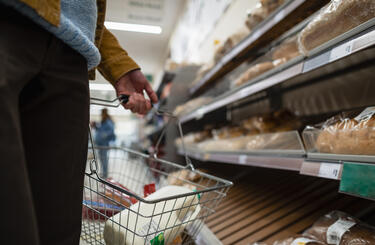
Maintaining food quality standards while reducing waste

UK-based supermarket chain Morrisons is scrapping use-by dates on 90% of its own-brand milk, with the aim of reducing milk waste dramatically. How does such a move impact on quality standards?
The facts around food waste in the UK make stark reading. According to the Waste & Resources Action Programme (WRAP), 10m tonnes of food waste is generated every year in the country, with around 70% of this coming from households.
As well as the high cost of such waste to household incomes, the volume of food and drink wasted annually exacts a huge toll on the environment. If global food waste were a country, it would have the third-biggest carbon footprint after the US and China. A prime example is milk production, which has a significant carbon footprint because it is so resource-intensive. One litre of milk potentially accounts for up to 4.5kg of CO2.
One of Britain’s leading supermarket chains, Morrisons, hit the headlines in January when it announced that, from the end of the month, it would scrap use-by dates on 90% of its own-brand milk. Milk is the third-most wasted food and drink product in the UK, behind potatoes and bread, with around 490m pints wasted each year. Of that figure, WRAP estimates that 85m pints of milk, worth around £270m, is wasted annually because of people observing use-by dates on the label.
Maintaining quality standards
Reducing food waste has huge and obvious environmental and economic benefits, but how can rigorous food quality standards, as set out in ISO 22000 food safety management, be maintained if the guidelines put in place for consumers are altered or removed entirely?
Two dates on food and drink products hold the key to this. Best-before dates relate to quality, while use-by dates focus on safety, as clearly defined by the UK’s Food Standards Agency (FSA).
Unlike some other fresh products, drinking milk after a best-before date is not a safety issue, although maintaining the quality standard of the product remains paramount for producers and retailers.
Two-year project
Speaking on BBC Radio 4’s Today programme after Morrisons’ announcement was made, the supermarket’s Technical Director, Ruth McDonald, noted: “It has taken us two years of working with Arla, our major supplier of milk, and a really in-depth piece of work, engaging with all the relevant authorities and satisfying ourselves that this [removing use-by dates on own-brand milk] is safe to do from a food-safety perspective.”
Helen White, Special Advisor on Household Food Waste at WRAP, as well as the organisation’s citizen-facing brand Love Food Hate Waste, has long been at the forefront of the move to make labelling changes to reduce food waste.
“A use-by date is about food safety; if it is past the use-by date, we, and the FSA, say that you absolutely shouldn’t use it, even if it looks and smells OK,” she explains. “The best-before date is the quality date, so Morrisons has obviously satisfied itself with scientific research that means it can safely move its milk from a safety marker to a quality marker.
“What a quality marker means is that the safety issue is removed. You often see a best-before on items that have longer life, such as dried goods and canned goods. What that means is, if it has gone past the best-before date you can use your judgement to decide if it is still good to eat, in the same way that you would look at a carrot and decide if it is still OK to use.
Moving from a use-by date, which is a hard stop, to a best-before date gives consumers a bit more time, because the product remains safe and retains that quality standard, which means less food is wasted.
“As technology develops and we change the way we manufacture things, it allows producers to make these types of changes. Moving from a use-by date, which is a hard stop, to a best-before date gives consumers a bit more time, because the product remains safe and retains that quality standard, which means less food is wasted.”
Reducing food waste, while maintaining the highest quality standards, is an issue being addressed head on in the UK, as White explains.
“In the UK, we tackle reducing food waste with a farm-to-fork approach called the Courtauld Commitment. It tackles every step of the food chain after the farm gate, drawing in different areas such as manufacturers, retailers, hospitality and the food-service sector, as well as local authorities, charities and food bodies.
“Originally, the focus of Courtauld was on making changes to packaging to reduce waste. However, food became a main focus and, in 2015, we launched Courtauld 2025, placing the emphasis firmly on food. Now we are working to Courtauld 2030, because that lines it up with the UN’s sustainable development goal, leading to a reduction in greenhouse gas emissions to help achieve global environmental goals.”
Find out more about the Waste & Resources Action Programme.